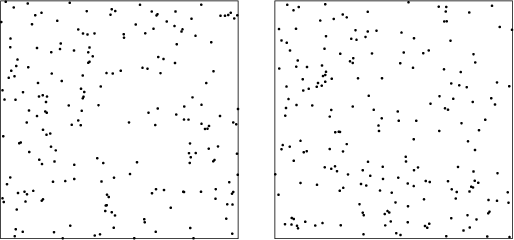|
|
|
Let ![]() ,
, ![]() , ... be an infinite series of real numbers lying between 0 and 1. Then corresponding to any arbitrarily
large
, ... be an infinite series of real numbers lying between 0 and 1. Then corresponding to any arbitrarily
large ![]() , there exists a positive integer
, there exists a positive integer ![]() and two subintervals of equal length such that the number of
and two subintervals of equal length such that the number of ![]() with
with ![]() ,
2, ...,
,
2, ..., ![]() which lie in one of the subintervals differs from the number of such
which lie in one of the subintervals differs from the number of such ![]() that lie in the other subinterval
by more than
that lie in the other subinterval
by more than ![]() (van der Corput 1935ab, van Aardenne-Ehrenfest 1945, 1949, Roth 1954).
(van der Corput 1935ab, van Aardenne-Ehrenfest 1945, 1949, Roth 1954).
This statement can be refined as follows. Let ![]() be a large integer and
be a large integer and ![]() ,
, ![]() , ...,
, ..., ![]() be a sequence of
be a sequence of ![]() real
numbers lying between 0 and 1. Then for any integer
real
numbers lying between 0 and 1. Then for any integer ![]() and any real number
and any real number ![]() satisfying
satisfying ![]() , let
, let
![]() denote the number of
denote the number of ![]() with
with ![]() , 2, ...,
, 2, ..., ![]() that satisfy
that satisfy
![]() . Then there exist
. Then there exist
![]() and
and ![]() such that
such that

This result can be further strengthened, which is most easily done by reformulating the problem. Let ![]() be an integer and
be an integer and
![]() ,
, ![]() , ...,
, ..., ![]() be
be ![]() (not necessarily distinct) points in the square
(not necessarily distinct) points in the square ![]() ,
, ![]() . Then
. Then
Similarly, the discrepancy of a set of ![]() points in a unit
points in a unit ![]() -Hypercube satisfies
-Hypercube satisfies
See also 18-Point Problem, Cube Point Picking
References
Berlekamp, E. R. and Graham, R. L. ``Irregularities in the Distributions of Finite Sequences.'' J. Number Th. 2, 152-161, 1970.
Roth, K. F. ``On Irregularities of Distribution.'' Mathematika 1, 73-79, 1954.
Roth, K. F. ``On Irregularities of Distribution. II.'' Comm. Pure Appl. Math. 29, 739-744, 1976.
Roth, K. F. ``On Irregularities of Distribution. III.'' Acta Arith. 35, 373-384, 1979.
Roth, K. F. ``On Irregularities of Distribution. IV.'' Acta Arith. 37, 67-75, 1980.
van Aardenne-Ehrenfest, T. ``Proof of the Impossibility of a Just Distribution of an Infinite Sequence Over an Interval.''
Proc. Kon. Ned. Akad. Wetensch. 48, 3-8, 1945.
van Aardenne-Ehrenfest, T. Proc. Kon. Ned. Akad. Wetensch. 52, 734-739, 1949.
van der Corput, J. G. Proc. Kon. Ned. Akad. Wetensch. 38, 813-821, 1935a.
van der Corput, J. G. Proc. Kon. Ned. Akad. Wetensch. 38, 1058-1066, 1935b.
|
|
|
© 1996-9 Eric W. Weisstein